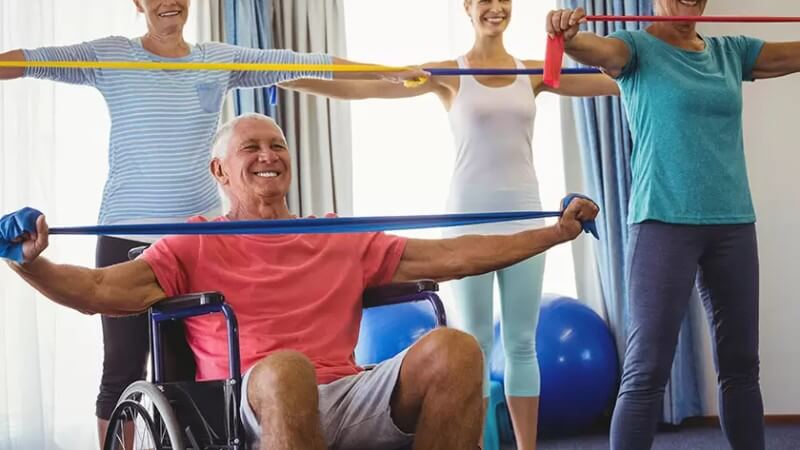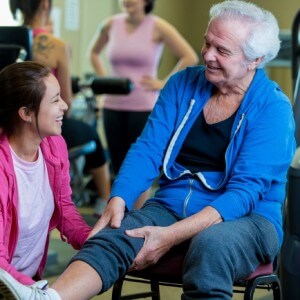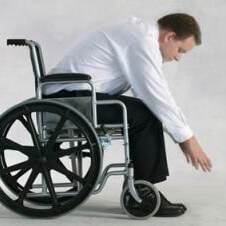Easy Stretches for Seniors in Wheelchairs: Boosting Mobility and Flexibility
Exercise is not just a luxury; it’s a necessity, especially for seniors in wheelchairs. While mobility challenges can make certain activities difficult, it doesn’t mean that physical activity should be sidelined.
In fact, for seniors who spend most of their time in wheelchairs, exercise becomes even more crucial. It helps in maintaining muscle strength, improving circulation, and boosting mental well-being.

Benefits of Stretching for Overall Health and Mobility
- Enhanced Flexibility: Regular stretching can increase flexibility, which is particularly beneficial for seniors in wheelchairs. It helps in reducing muscle stiffness and increasing range of motion.
- Improved Circulation: Stretching promotes better blood flow, ensuring that muscles and joints receive adequate nutrients and oxygen. This can aid in faster recovery from muscle soreness and reduce the risk of injuries.
- Mental Well-being: Engaging in stretching exercises can also have a positive impact on mental health. It can act as a stress-reliever, reduce anxiety, and promote a sense of well-being.
- Posture and Balance: For seniors in wheelchairs, maintaining a good posture is essential. Stretching can help in correcting postural imbalances and enhancing overall body alignment.
Incorporating stretching into daily routines can be a game-changer for seniors in wheelchairs. It not only offers physical benefits but also contributes to emotional and mental well-being.
So, let’s dive deep into the world of stretches tailored for our seniors and discover the myriad benefits they offer!
Understanding the Challenges
Physical Limitations of Seniors in Wheelchairs

Life in a wheelchair presents its own set of unique challenges, especially for seniors. As age progresses, muscle strength tends to diminish, flexibility reduces, and the range of motion can be limited. For seniors in wheelchairs, these physical limitations are further compounded.
They often face difficulties in performing daily activities, which many of us take for granted. Simple tasks like reaching out for an object, bending over, or even turning around in the chair can become daunting. These physical constraints can sometimes lead to feelings of dependence, frustration, and even isolation.
The Need for Specialized Exercises
Given these challenges, it’s evident that generic exercises might not be suitable for seniors in wheelchairs. They require:
- Tailored Workouts: Exercises specifically designed to cater to their unique physical needs, ensuring they are both effective and safe.
- Focus on Core Strength: Since the core plays a pivotal role in balance and posture, especially for wheelchair users, exercises should emphasize strengthening this area.
- Flexibility Training: To combat stiffness and enhance the range of motion, flexibility exercises are crucial.
- Guided Sessions: Given the specialized needs, it’s beneficial to have guided sessions, possibly with a physiotherapist or trained instructor, to ensure the exercises are done correctly.

Understanding the challenges faced by seniors in wheelchairs is the first step. The next is to provide them with the right tools and exercises to help them lead a more active, independent, and fulfilling life.
Upper Body Stretches
Arm Raises
- Importance of strengthening arms for wheelchair users:
For seniors in wheelchairs, the arms play a pivotal role in daily activities, from propelling the wheelchair to reaching for objects. Strengthening the arms not only enhances mobility but also boosts independence by enabling tasks like self-transfer and lifting objects.

- Benefits:
- Improved muscle tone and strength
- Enhanced wheelchair propulsion efficiency
- Reduced strain on shoulders and wrists
- Increased range of motion
- Step-by-step guide to performing the stretch:
- Sit upright in the wheelchair with feet flat on the ground.
- Extend both arms out to the side at shoulder height.
- Slowly raise your arms upwards until they are pointing towards the ceiling.
- Hold the position for a few seconds.
- Gradually lower your arms back to the starting position.
- Repeat the exercise 10-15 times.
Aeroplane Arms
- Benefits of this warm-up exercise:
Aeroplane arms serve as an excellent warm-up, preparing the upper body for more intensive stretches. This exercise promotes shoulder flexibility and aids in relieving tension in the upper back.

- Benefits:
- Improved shoulder mobility
- Enhanced blood circulation in the upper body
- Reduction of upper back and shoulder tension
- How to perform with variations:
- Sit upright with arms extended at shoulder height.
- Rotate your arms in small circles, gradually increasing the circle’s size.
- After 10 rotations, reverse the direction.
- For a variation, try alternating the arms or incorporating wrist rotations.
Side Twists
- Strengthening the core and its benefits:
A strong core is crucial for maintaining balance, ensuring proper posture, and providing overall support to the spine. For wheelchair users, a robust core can aid in activities like transfers, turns, and lifts.

- Benefits:
- Enhanced posture and spinal support
- Improved balance and stability
- Reduced risk of back pain
- Detailed guide to the exercise:
- Sit upright with feet flat on the ground.
- Place your hands on your shoulders or cross them over your chest.
- Slowly rotate your upper body to the right, keeping your hips stationary.
- Hold the twist for a few seconds.
- Return to the center and repeat on the left side.
- Perform 10-15 repetitions on each side.
Engaging in these upper body stretches can significantly enhance the quality of life for seniors in wheelchairs. Not only do they promote physical well-being, but they also instill a sense of independence and confidence in one’s abilities.
Lower Body Stretches
Stretching the lower body is crucial, even for those who spend most of their time in a wheelchair. Let’s dive into some effective exercises that can be done while seated, focusing on the fun and functionality they bring.
Toe Taps
The Fun Element: Imagine tapping your toes to the rhythm of your favorite song! Toe taps aren’t just an exercise; they can be a delightful activity when paired with music. It’s a way to combine fun with fitness.
Step-by-step guide:
- Sit upright in your wheelchair with your feet flat on the ground.
- Lift the toes of both feet while keeping your heels on the ground.
- Tap your toes back down.
- Repeat this motion, gradually increasing your speed. For added fun, do it to the beat of a song!

Knee Lifts
Why It Matters: For wheelchair users, the legs might not bear weight, but they still play a crucial role in overall health and balance. Strengthening them can aid in transfers, posture, and even circulation.
How to Perform Knee Lifts Effectively:
- Sit tall with your feet flat on the floor.
- Hold onto the sides of your wheelchair for support.
- Slowly lift one knee toward your chest as high as comfortably possible.
- Lower it back down gently.
- Repeat with the other leg.
- Continue alternating legs for several repetitions.

Remember, every movement counts. These exercises not only enhance physical well-being but also uplift mood and boost confidence. So, let’s get moving and add some rhythm to our routine!
Core Strengthening Exercises
The core is often referred to as the powerhouse of the body. It’s the central link that connects your upper and lower body, and for wheelchair users, a strong core is even more vital. Let’s delve into some core-strengthening exercises tailored for those in wheelchairs.

Tummy Twist
- Benefits of a Strong Core for Wheelchair Users:
- Provides better balance and stability
- Aids in daily activities like transfers and turns
- Reduces the risk of back pain and injuries
- Enhances posture and spinal support
- Detailed Guide to the Exercise:
- Sit upright in your wheelchair.
- Place your hands on your shoulders or cross them over your chest.
- Slowly rotate your upper body to one side, keeping your hips stationary.
- Hold for a few seconds and then return to the center.
- Repeat on the other side.
Captain’s Chair
- Strengthening the Abs and Its Importance:
- A strong abdominal region supports the spine and reduces strain.
- It aids in maintaining an upright posture.
- Enhances mobility and ease of movement.
- How to Perform the Exercise Safely:
- Sit at the edge of a stable chair or bench.
- Hold onto the sides of the chair for support.
- Slowly lift both knees towards your chest.
- Lower them back down without letting your feet touch the ground.
- Repeat several times.
The Side Bend Stretch
- Improving Flexibility and Its Benefits:
- Enhances the range of motion
- Reduces muscle stiffness and soreness
- Promotes better blood circulation
- Step-by-step Guide:
- Sit upright with your feet flat on the ground.
- Extend one arm overhead while keeping the other on your lap or holding the wheelchair.
- Bend to the opposite side, feeling a stretch along the side of your body.
- Hold for a few seconds and then return to the starting position.
- Repeat on the other side.
Strengthening the core while in a wheelchair might seem challenging, but with the right exercises and consistency, it’s entirely achievable. Remember, every little movement counts towards building a stronger, healthier you!
Additional Tips and Precautions
Maintaining Good Posture

- Why it’s crucial: Maintaining a good posture during exercises is paramount, especially for wheelchair users. A proper posture ensures that the right muscles are engaged, reducing the risk of strain or injury. It also maximizes the benefits of each exercise.
- Tips for good posture:
- Keep your spine aligned and avoid slouching.
- Engage your core muscles.
- Ensure your wheelchair is at the right height and angle.
Starting Slow and Gradually Increasing Intensity
- The importance of pacing: Jumping into intense exercises can be harmful, especially if you’re not accustomed to regular physical activity. Starting slow allows your body to adapt, reducing the risk of injuries.
- How to pace yourself:
- Begin with low-impact exercises.
- Gradually increase the duration and intensity as your stamina and strength improve.
- Listen to your body. If something feels off, take a break.
Consulting with a Physiotherapist or Fitness Expert

- Why it’s essential: Every individual’s needs and capabilities are different. Consulting with a professional ensures that you’re doing exercises that are beneficial and safe for you.
- Benefits of professional guidance:
- Personalized exercise routines tailored to your needs.
- Expert advice on improving technique and posture.
- Recommendations on equipment or tools that can aid in your exercises.
Remember, the journey to fitness is a marathon, not a sprint. It’s essential to prioritize safety and well-being over rapid results.
By following these tips and precautions, you can ensure a healthier and more effective exercise routine.
FAQs
Why is exercise important for seniors in wheelchairs?
Exercise is crucial for seniors in wheelchairs for several reasons:
Maintaining Physical Health: Regular exercise helps in strengthening muscles, improving flexibility, and enhancing overall physical health.
Mental Well-being: Physical activity can boost mood, reduce feelings of depression, and improve cognitive functions.
Independence: Strengthening core muscles and improving physical stamina can aid in daily activities, promoting a sense of independence.
Social Interaction: Group exercises provide an opportunity for social interaction, reducing feelings of isolation.
How often should these stretches be performed?
It’s generally recommended that seniors in wheelchairs engage in stretching exercises at least 2-3 times a week. However, the frequency can vary based on individual health conditions and the advice of healthcare professionals.
Are there any exercises to avoid?
Yes, not all exercises are suitable for everyone. Seniors in wheelchairs should avoid exercises that:
Put undue strain on joints.
Cause pain or discomfort.
Are not recommended by their healthcare provider.
It’s always best to consult with a physiotherapist or fitness expert before starting any new exercise regimen.
How to ensure safety while exercising?
To ensure safety:
Consultation: Always consult with a healthcare professional before starting any exercise regimen.
Proper Technique: Ensure that exercises are performed with the correct technique to avoid injuries.
Stay Hydrated: Drink adequate water before, during, and after exercising.
Listen to Your Body: If any exercise causes pain or discomfort, stop immediately and seek advice.
